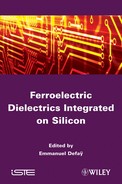Table of Contents
Chapter 1. The Thermodynamic Approach
1.3. Linear equations, piezoelectricity
1.4. Nonlinear equations, electrostriction
1.5. Thermodynamic modeling of the ferroelectric–paraelectric phase transition
Chapter 2. Stress Effect on Thin Films
2.2. Modeling the system under consideration
2.3. Temperature–misfit strain phase diagrams for monodomain films
2.5. Temperature–misfit strain phase diagram for polydomain films
2.6. Discussion of the nature of the “misfit strain”
2.8. Experimental validation of phase diagrams: state of the art
2.11. Comparison between the experimental data and the temperature–misfit strain phase diagrams
Chapter 3. Deposition and Patterning Technologies
3.4. Monocrystalline thin-film transfer
Chapter 4. Analysis Through X-ray Diffraction of Polycrystalline Thin Films
4.2. Some reminders of x-ray diffraction and crystallography
4.3. Application to powder or polycrystalline thin-films
4.4. Phase analysis by X-ray diffraction
4.5. Identification of coherent domain sizes of diffraction and micro-strains
4.6. Identification of crystallographic textures by X-ray diffraction
4.7. Determination of strains/stresses by X-ray diffraction
Chapter 5. Physicochemical and Electrical Characterization
5.2. Useful characterization techniques
5.3. Ferroelectric measurement
Chapter 6. Radio-Frequency Characterization
6.2. Notions and basic concepts associated with HF
6.3. Frequency analysis: HF characterization of materials
Chapter 7. Leakage Currents in PZT Capacitors
7.2. Leakage current in metal/insulator/metal structures
7.3. Problem of leakage current measurement
7.4. Characterization of the relaxation current
7.5. Literature review of true leakage current in PZT
7.6. Dynamic characterization of true leakage current: I(t, T)
7.7. Static characterization of the true leakage current: I(V, T)
Chapter 8. Integrated Capacitors
8.2. Potentiality of perovskites for RF devices: permittivity and losses
8.3. Bi-dielectric capacitors with high linearity
8.4. STO capacitors integrated on CMOS substrate by AIC technology
Chapter 9. Reliability of PZT Capacitors
9.2. Accelerated aging of metal/insulator/metal structures
9.3. Accelerated aging of PZT capacitors through CVS tests
9.4. Lifetime extrapolation of PZT capacitors
Chapter 10. Ferroelectric Tunable Capacitors
10.2. Overview of the tunable capacitors
10.3. Types of actual tunable capacitors
10.4. Toward new tunable capacitors
Chapter 11. FRAM Ferroelectric Memories: Basic Operations, Limitations, Innovations and Applications
11.1. Taxonomy of non-volatile memories
11.2. FRAM memories: basic operations and limitations
11.3. Technologies available in 2011
11.4. Technological innovations
11.5. Some application areas of FRAM technology
Chapter 12. Integration of Multiferroic BiFeO3 Thin Films into Modern Microelectronics
12.3. Ferroelectricity and magnetism
